Episode 153
What you’ll learn in this episode:
- How Jonathan moved from sculpture to jewelry to drawing, and why he explores different ideas with each medium
- How the relationship between craft and fine art has evolved over the years
- Why people became more interested in jewelry during the pandemic
- Why jewelers working in any style benefit from strong technical skills
- How you can take advantage of the 92nd Street Y’s jewelry programming and virtual talks
About Jonathan Wahl
Jonathan Wahl joined 92nd Street Y in July 1999 as director of the jewelry and metalsmithing program in 92Y’s School of the Arts, the largest program of its kind in the nation. He is responsible for developing and overseeing the curriculum, which offers more than 60 classes weekly and 15 visiting artists annually. Jonathan is also responsible for hiring and supervising 25 faculty members, maintaining four state-of-the-art jewelry and metalsmithing studios, and promoting the department locally and nationally as a jewelry resource center.
Named one of the top 10 jewelers to watch by W Jewelry in 2006, Jonathan is an accomplished artist who, from 1994 to 1995, served as artist-in-residence at Hochschule Der Kunst in Berlin, Germany. He has shown his work in the exhibitions Day Job (The Drawing Center), Liquid Lines (Museum of Fine Arts Houston), The Jet Drawings (Sienna Gallery, Lenox MA, and SOFA New York), Formed to Function (John Michael Kohler Arts Center), Defining Craft (American Craft Museum), Markers in Contemporary Metal (Samuel Dorsky Museum of Art), Transfigurations: 9 Contemporary Metalsmiths (University of Akron and tour), and Contemporary Craft (New York State Museum).
Jonathan was awarded the Louis Comfort Tiffany Emerging Artist Fellowship from the Louis Comfort Tiffany Foundation, two New York Foundation for the Arts Fellowships in recognition of “Outstanding Artwork,” and the Pennsylvania Society of Goldsmiths Award for “Outstanding Achievement.” As part of the permanent collections of The Metropolitan Museum of Art in New York, The Museum of Fine Arts in Houston, TX, and The Museum of Arts and Design in New York, his work has been reviewed by Art in America (June, 2000), The New York Times (June 2005), and Metalsmith Magazine (1996, 1999, 2000 2002, 2005, 2009); his work was also featured in Metalsmith Magazine’s prestigious “Exhibition in Print” (1994 and 1999). Jonathan’s art work can be seen at Sienna Gallery in Lenox, Massachusetts, which specializes in contemporary American and European art work, and De Vera in Soho, New York. His work can also be seen in the publications The Jet Drawings (Sienna Press, 2008), and in three collections by Lark Books: 1,000 Rings, 500 Enameled Objects and 500 Metal Vessels.
Before joining 92Y, Jonathan was, first, director of the jewelry and metalsmithing department at the YMCA’s Craft Students League, and later assistant director of the League itself. Mr. Wahl holds a B.F.A. in jewelry and metalsmithing from Temple University’s Tyler School of Art and an M.F.A. in metalsmithing and fine arts from the State University of New York at New Paltz. He is a member of the Society of North America Goldsmiths.
Additional Resources:
- Website: www.jonathanwahl.com
- Website: www.92y.org/jewelry
- LinkedIn: www.linkedin.com/in/jonathancwahl
- Instagram: @jonathancwahl/
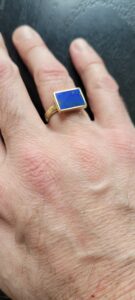

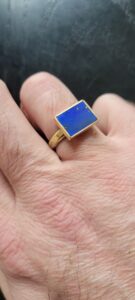
Jonathan Wahl, Life Liberty, 17x12x6, fabricated tin Museum of Fine Ars Boston
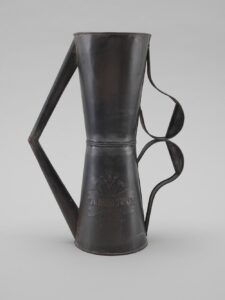
Jonathan Wahl, Life Liberty detail 17x12x6, fabricated tinware 1994 Museum of Fine Arts Boston
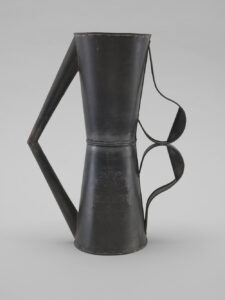
Black Waterfall 2, positive & negative comparison
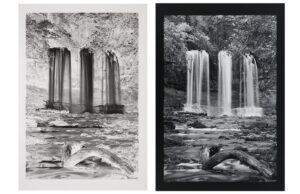
Transcript:
With more than 60 jewelry classes offered weekly, the 92nd Street Y’s Jewelry Center is by far the largest program of its kind in the country—and it’s all run by award-winning sculptor, jeweler and artist Jonathan Wahl. He joined the Jewelry Journey Podcast to talk about the different relationships he has with jewelry and sculpture; why craftsmanship should be embraced by the art world; and what he has planned for 92Y in 2022. Read the episode transcript here.
Sharon: Hello, everyone. Welcome to the Jewelry Journey Podcast. This is the second part of a two-part episode. Today, my guest is Jonathan Wahl, Director of the Jewelry Center of the 92nd Street Y in New York City. The program is the largest of its kind in the country. In addition to his life in jewelry, Jonathan is an award-winning artist whose work is in the permanent collections of prestigious museums. Welcome back.
When do you have time to work on your jewelry?
Jonathan: I’m here Monday through Wednesday in the studio here. Then I’m in my studio the rest of the time, so Thursday, Friday, Saturdays and Sundays.
Sharon: Your home studio or a studio at the Y?
Jonathan: No, it’s not here. It’s in Brooklyn. I wouldn’t be able to work here. People would be finding me. No, I maintain a studio in Brooklyn. That’s where I’ve done all my work basically for the past 25 years.
Sharon: Tell us about your work. I was reading about you. You have a whole series of different things, drawings, collections.
Jonathan: Lest I forget, I have had a jewelry line. In 2005—and I’ll get to the larger bodies of work—when I moved to New York, my work was primarily sculpture. It was the tinware. It became the oversize tinware. I got a Tiffany fellowship which gave me a nice chunk of cash, and I made a series of work based on Frederic Remington, a series called Cowboys and Unicorns. I made a series of tasseled heads for this exhibition. It took about a year. There were many bodies of work, like Aztec Astronauts, which is inspired by Jared Diamond’s book, “Guns, Germs, and Steel.” There’s no jewelry in it at all, but it was interesting. I had a wonderful Foundation for the Arts fellowship for Cowboys and Unicorns. I had this Tiffany fellowship. I thought I was hot to trot. I was an artist, but because I’ve also been very self-directed in my work, I have made choices on my own, and I certainly hadn’t thought of the larger picture, like, “Who am I marketing to?”
At one point, I felt like maybe I should do something different. I saw these people putting jewelry lines together and I thought, “Well, let me try that. I’m going to throw together a jewelry line.” I did put together a jewelry line in 2004 and 2005, and it got a lot of press. Barneys called and Bergdorf called. It was exciting and, true to myself, I looked at this opportunity and thought, “What they’re asking for sounds like I’m going to have to start a real business.” Between my role here as Director of the Jewelry Center and my studio practice, I wasn’t sure I wanted to run a full-time jewelry business.
What this position here affords me is the time and space to work in my studio on what I want to make. I thought that if I put together a jewelry line, that was a different kind of hustle, and a hustle that was going to take over. As a consequence, I declined Barneys and Bergdorf. I did sell my line at De Vera in New York, which is a much more boutique, gorgeous store that has since moved. Interestingly enough, launching the jewelry line brought me to drawing. People who knew me and knew my work as a sculptor, when I said I’d launched a jewelry line, to put it politely, they looked confused. I’ve said this in many interviews: a jeweler in the art world, people don’t really get. An artist who makes jewelry is different than a jeweler who makes art, may I say.
Sharon: That’s interesting.
Jonathan: I think that has changed. It has changed to some extent, but it’s different. It’s a one-way street. A potter and a sculptor, interesting, particularly with clay being very hot right now. A painter and a bartender makes sense; people get that. Anyway, I found this look of confusion quite perplexing. I started these large drawings, renderings of jet jewelry. I was working on a series of drawings about jewelry, about history, about my love for history, and I happened upon jet jewelry. I thought it was so out of the ordinary: monochromatic, at times really epoch-shifting in terms of what it was. So, I decided to start drawing these objects to take them out of the realm of jewelry and present them to the viewer as an object. Rendered large, they took on a completely different identity. It paralleled my experience of having this conversation with people saying I’m a jeweler and a sculptor. I thought, “If I present them with these drawings that are straight-up portraits of jewelry, maybe they’ll think differently about what those edges are about or what those lines are, what those determinations are.”
Sharon: That’s interesting about people not getting a jeweler as a painter or an artist. That’s what you said, right?
Jonathan: I wish I could deny it. Again, this is 20 or 15 or 17 years ago; I can’t remember. Things have changed a lot in the art world. I’ll probably get in trouble for this; I don’t know if any of the Whitney curators are going to hear this, but the Whitney, one of my favorite museums, had an exhibition of artists who employ craft, I think. It was all artists who made objects or used material that represented craft in some way. It was such an artist’s use of craft, and done in a way that was pure aesthetics and abstraction, which was such a different experience with respect to the materials that I think a craftsperson has. I also find that curators are really only looking at artists who use craft techniques or craft materials from this artistic, old-school, may I say modernist perspective.
I truly mean that because it was fascinating to see how a fine art museum presented craft in this way. To me, it reiterated how these fields are viewed, certainly from each corner of the art world. I found the show at the Whitney really underwhelming in terms of how they represented craft. Just because you use yarn doesn’t mean it’s craft. That’s the takeaway. I think that represents this weird, one-way street or one-way mirror of how crafts and art are viewed together. Martin Puryear was not in that show.
Sharon: Pardon?
Jonathan: Martin Puryear, whose work definitely involves craftsmanship. He wasn’t in that exhibition. There were people who I thought could have been in that exhibition to represent how craft is employed in the fine art world and would have made the statement better.
Sharon: So, what is craft? It always seems to me the question that’s has no answer. How do you know, when you’re looking at something, whether it’s craft or fine art or jewelry made with yarn? What’s the difference? Not difference, but how do you separate it?
Jonathan: I think it’s many times subjective. To that point, the curators at the Whitney could have put whatever they wanted and called it craft, but I think when you see craft, you know it. I think you really do. I think their lines can be crossed. I think there’s craft that’s art, and I think there’s art that’s craft, but for myself, I know it when I see it.
I think it also depends on how you employ the materials and for what end. I’ve been thinking about this recently. Craft was never really thought of as espousing an agenda other than its function. That was how it started, but now in some ways, the art world is looking at craft that explores itself beyond its function. It’s making social commentary and is actually functioning in the way fine art would have explained itself, as material subjugated to the thought process of the artist. Craftsmen can be both, explaining or using functional materiality. They can also use a fine arts strategy, if they’re making a commentary or going beyond the object’s functionality into a realm that makes you think about the object differently. That is more of a fine arts strategy. So, it gets really sticky.
Sharon: It’s one of those questions. I’m thinking about craft in jewelry. I’m thinking about when you were in camp, the lanyards you would make, the necklaces you’d make with plastics. I guess you could call it a type of craft jewelry.
Jonathan: For sure. I don’t think craftsmen should be offended by lanyard jewelry. That’s how you start. It’s weaving; it’s one of the most basic weaving skills. Voice that history. Those are old skills. That’s how we built civilization. Believe in that. We wouldn’t be here without those skills. Don’t be afraid of that. I think my own jewelry journey, if you will, has been influenced by these experiences. I love jewelry. I love objects. I love technique. I love skill. I’m so in awe of people who can make, who can really fabricate something. It takes skill. It takes work. It takes focus.
I love jewelry. I wear one ring and a watch. I change my ring up whenever I feel like that. They’re mostly rings I’ve made, but they’re a specific type of ring. Apart from my look in the 80s, I’m a relatively conservative-looking guy, so I wear jewelry that reflects the aesthetics of myself. It tends to be kind of traditional, so I have no problem with great jewelry that has a great stone, that’s made well, that some would consider traditional. I’m O.K. with that. You know what? Wear whatever kind of jewelry makes you feel right.
I love art jewelry and I think it’s important in pushing the boundaries or the materiality of the field. I’m happy to see and support that. I love going to SCHMUCK. I’m always blown away when I see what’s happening in the world of contemporary jewelry. I think contemporary or art jewelry, the field is also changing. I have to say everything’s moving more towards the middle in a way, whether it’s contemporary jewelry, studio jewelry or art jewelry. When I look at work today, it’s all moving a little bit towards the middle, which is fascinating. But when it comes to jewelry, I don’t have any problem with good jewelry, period. I love good jewelry.
Sharon: Big stones are nice.
Jonathan: I’m just saying good jewelry, however you classify jewelry, I like jewelry.
Sharon: Why are things moving towards the middle? Why do you think that? Is that part of the ethos of the country, or that people don’t want to be extreme? They don’t want purple hair anymore?
Jonathan: With all that being said, the generation that’s coming up now wants to have purple hair, absolutely. I look at the trends that are going on right now, and I think of myself in art school in the high 80s with my hoop earrings and my dyed red hair and my capri pants and my corny shoes and my vests and yada, yada, yada. I look at this younger generation thinking, “Wow, it’s coming back around again, interesting.” Maybe I talk out of two sides of my mouth, but I think in general, the bulk of those fields are moving a little bit closer together. I think there’s an appreciation in the art jewelry world for techniques and processes that might not have been so accepted 10 or 20 years ago. I think there’s an appreciation all around. I think I see contemporary jewelry making gestures that might have only happened in the art jewelry world 10 or 20 years ago.
Sharon: You also talk about the rift between fine art and jewelry. Can you talk a little bit about that?
Jonathan: I’ve got to say, I’ve met some great fine art collectors in New York and their jewelry has really stunk. I find it really funny when I see people who’ve got a great dress on and have a great art collection and mundane jewelry. It’s the last thing that people think about sometimes. Although, the one person I’ll say that always bucks the trend is Lindsay Pollock, who has great jewelry and has great art and knows great art.
Sharon: Who? I’m sorry; I didn’t hear.
Jonathan: Lindsay Pollock, who used to be an editor at Art Forum. Now she also works for the Whitney Museum of Art, I think, as Director of Communications. I’m not sure, but she’s a wonderful collector.
Sharon: And she has great jewelry.
Jonathan: Yes, and she knows the art world really well. Your question; please repeat it.
Sharon: The rift between fine art and jewelry. Is there a rift?
Jonathan: There’s a difference. I think for so long people were trying to justify themselves, so people got defensive. Now people are starting to own what they do and who they are without the defense: “I’m not an artist, I’m a craftsperson” or “I’m a craftsperson, not an artist.” I think there’s less apprehension about that now in terms of owning those fields. This is a conversation had by many people, but when modernism took its toll on craft, it stepped up its identity in many ways. I think since then, craftsmen and jewelers have been trying to figure out their way back to be on par with the rest of the arts. I think for a long time, because it wasn’t modern art or contemporary art, there was a real apprehension about how we define artwork.
I think about how jewelry was, for a long time, just photographed on a white background so it reads as an object, like you’re presenting it like a little sculpture. For many years, that’s how it was presented. I find that representative of how we explain the work we were making. When you saw it, you generally saw it sitting on nothing except white, in a void, outside of any wearability or reference to the person, which I get. But when you think about that, for me, it has resonance. I also think that’s kind of who we are and what we do. I think that’s changing to some extent, but the art world and the craft world have been trying to figure out the relationship for a while.
Sharon: Do you make jewelry now?
Jonathan: I do. I just made a ring for myself with a beautiful piece of lapis that I came across. It’s very plain and modernist. I had an old necklace from my former landlord who passed away and left it to me. I melted down this necklace, I milled the jewelry, I rolled down the sheet and I made a half-round wire that I put through the mill again so it was more like a trapezoid and set it again. Man, I was a jeweler for a day. I love good jewelry, and I like to represent.
Sharon: You like to represent? What do you mean?
Jonathan: I like to represent the field with a good piece of jewelry.
Sharon: Wow! You made the sheet metal and then you rolled your wire. The first time I saw somebody rolling wire, I thought, “You could buy wire. Why would anybody roll it?”
Jonathan: One great thing is I didn’t have to buy new gold. Another great thing is I’m recycling the gold. I recycle, recycle, recycle whenever possible. I worked it all the way down, but I do not have a jewelry line. I rarely make jewelry on commission. Most of my studio practice is focused in other ways, although as I’ve been drawing for the past 12 years, I recently picked up my tin shears again. I have actually been making more tinwork, which is also reflective of our current state of politics and our country again. It’s been fascinating to work in metal again, so stay tuned.
Sharon: How does it reflect where we are as a country or politically?
Jonathan: I’m making tinware again, and I think a lot of what’s in question right now in our country is what is traditional? Who are Americans? There’s a lot of questioning about do you fit, do you belong, what are those parameters, how are you judged as an American or not as an American. The painted tin I’m making right now is so understood as a traditional object and a traditional way of making. Mixing and presenting that work within this very traditional material and history of making is, again, a metaphor for traditionality. The viewer automatically looks at this thing and things it’s an original object. It’s meant to look very traditional, although right now I’m working on a six-foot-by-four-foot painted stenciled decal tray, which, after a few minutes of looking at it, you will know is definitely not from the 19th century. But again, the techniques and the feeling and the look are traditional, I find that that’s what we’re questioning right now. We’re questioning what is traditional. What are these traditions?
The more I dig into these traditions, particularly in painted tinware—Japanware is what it was called. It was meant to imitate Japanese lacquerware. It had nothing to do with America. Another iteration is painted tinware that comes from a German and Scandinavian aesthetic, also not traditional American. So, these objects that you’d see in a folk museum and be like, “Yeah, Ohio, 1840, I got it,” these traditions and materials were not traditional until they became traditional. There’s a lot of this material culture history that I find fascinating. It’s very layered for me. I hope it’s as interesting to the viewer. I have never really found the right format for many of my ideas or questions that fit into jewelry, and that’s one of those cruxes. I’ve never found the right way for me to use jewelry or engage in jewelry with the same intents that I have in other materials or formats.
Sharon: What do you mean exactly? It doesn’t fit into a category?
Jonathan: No, I can be really political with this tinware. I’ve never figured out how to get the same effect, with the same feeling, in jewelry. I find, for me, the wearing of jewelry is the great part of it, and I don’t want my jewelry to say the same thing as my tinware. This is personal: I don’t want my jewelry to work the same way as this giant tinware piece does, because I like this ring that fits on my finger. I love it, and I love when I get compliments on it. I think jewelry is special. It’s great because we wear it.
As a sidenote, it was fascinating that during the pandemic, jewelry took off. Sales of jewelry took off. All my friends in the field of luxury jewelry and studio jewelry, they had great years. Jewelry is the stuff you take with you. Jewelry is the stuff you wear. Jewelry is the intimate stuff, and I think it was fascinating to know that in this time of extreme stress and trouble, people were going to jewelers to buy these things they could hold and keep and literally run with it if they had to. There is this intimacy of jewelry that people sought out, and that’s special. It doesn’t exist in other places. Those are the kinds of things, the resonance, that I want to embrace and love about jewelry and that I will not run away from.
One of the reasons why I started even playing around with images of jewelry, which led me to the drawings, is because I did this class at the Met called Into the Vaults. We went through all these different departments of the Met, jewelry and old jewelry. I came across the story of the Hannebery Pearls, which were pearls that were given to Catherine de Medici from her uncle, who was the Pope. This string of pearls went through the Hanoverians and then eventually into the British Crown Jewels. I thought, “Wow, if this string of pearls could talk, what we would know. What has it seen?” I was fooling around with this image of a gem, a ring that I had Photoshopped a historical scene from a movie on top of, so it almost looked like this gem was reflecting what it saw. I thought, “Wow, wouldn’t it be amazing if there was a ring from ancient Greece that was passed down every generation until now, and that ring was held and worn by 200 generations?” I don’t know how many generations that would be. That intimacy and history of an object doesn’t exist in other places in the same way, where it’s worn and carried with it. There’s something about the intimacy of jewelry and the history that it can be embraced in a specific way that I really love.
Sharon: It’s something very different and novel. I don’t know if it’s been done already.
Jonathan: I have an idea for a novel. I’ll talk about it off-camera. We should talk about it. It’s about that same kind of story, a will to survive.
Sharon: All right. Jonathan, thank you so much for talking with us today.
Jonathan: You’re welcome.
Sharon: I expect an invitation to the opening of the 92nd Street Y in Los Angeles. I can’t wait.
Jonathan: In the meantime, I hope you can come with us to Korea. As you know, I do trips around the world. South Korea is on the books, and there are a number of other wonderful things happening. The only residency for jewelry in New York City, called the JAIR, Jewelry Artist in Residence, that’s happening this summer. Applications are open on our website. We had applications from 50 countries in 2019. It has been suspended since the pandemic.
Another little sidenote: I’m excited about a program called Team Gems, which is a fully-funded program for high school kids in New York City, Title 1 high schools in New York City. It’s a fully-funded program for kids to get experience in jewelry that they wouldn’t normally have, and will maybe create a pathway for a career in jewelry outside the academic model. I hope I’m going to be able to tell you more about it, but it’s the first year and it’s very exciting. Also, keep your ears open for my new series of talks coming up. I think this topic is going to be about enamel, and then hopefully a series in June in honor of Pride Month. A lot’s going on at the Jewelry Center.
Sharon: Well, thank you for being here. We want to hear more about it in the future. Thank you so much, Jonathan. We greatly appreciate it.
Jonathan: Thank you, it’s such a pleasure. Be well.
Sharon: You, too.
Thank you again for listening. Please leave us a rating and review so we can help others start their own jewelry journey.

